#melbourne groupe trans
Explore tagged Tumblr posts
Text
#australia#melbourne groupe trans#trans woman#canberra#fishblr#trans muslimah sisterhood#trans love#transgender#alternative#grunge
8 notes
·
View notes
Text
Transphobia is so often transmisogyny since the focus tends to be on transwomen rather than transmen. Whether it's transwomen shouldn't be allowed to compete on women's sports teams since they have an unfair advantage, or they are danger in women's bathrooms.
As for the first claim, the argument is also based on the blatantly sexist premise that men are inherently superior to women in athletics. As to the second claim, do they honestly think a sign on the door is going to change a sex predator's behavior? Banning trans people from the bathrooms of the genders they identify with not only doesn’t generally protect anyone, but actually does the opposite given trans teens forced to use the restrooms of their assigned gender at birth suffer a sexual assault rate of 36%. Protecting women somehow never includes trans women with these people or even the trans men.
Just note how restrictive their definition of a woman is compared to that of a man. According to them a man can be a cis-man, an intersex woman with a vulva but has testes, or even a woman with a vulva and ovaries but has a higher level of testosterone compared to the average woman like the Olympic athlete Imane Khelif. However, a woman must always be a cis-woman with the right amount of hormones and fits a certain physical description.
As to the example with Imane, Rowling's definition of a women is "people who menstruate", and yet Imane fit that definition but that wasn't enough for Rowling apparently. Add the dimension of race and ethnicity, then it's not surprising that all the cis-women affected by these anti-trans rules are women of color. I wish her luck in her lawsuit against Rowling.
The ties of transphobia to the idea of white supremacy are already apparent with white supremacists groups like Proud Boys and neo-Nazis showing up at an anti-trans rally in Melbourne, protesting at a “Rock-n-Roll Humanist Drag Queen Story Hour,” at a library in Wadsworth, OH and harassing a drag brunch at Landgrant Brewing in the neighboring city of Columbus. It’s not new for Nazis either given the first books burned by the original Nazis in Germany were books on homosexuality, intersex and transgender issues of the Institute for Sexual Research, the world’s first trans clinic that marked the first time a transwoman underwent sexual reassignment surgery.
Hell, a lot of these transphobic folks when tend to be right-wingers fighting against women's rights like the Republican Party in the US trying to ban abortion alongside their anti-trans legislation. They also include the likes of pro-natalist and sexual harasser Elon Musk who exposed himself to and propositioned an employee and Andrew Tate.
Perhaps, it's not a good idea to leave the definition of women to men who define women by their ability to provide them with sex and serve as broodmares. It's why so much of the focus seems to be on transwomen.
Transmisogyny was never about protecting women from men, but protecting the rigid patriarchal standards as to the idea of what a woman should so as to preserve the patriarchy.
30 notes
·
View notes
Note
I have a story to share regarding older queer people.
So, I decided to meet up with my friend for a tour of the Victorian Pride Centre, which is a new-ish centre built to be a hub for many queer organisations and events in Melbourne. There was a lot of fascinating things on the tour - a small bookshop, a centre for a local queer radio station, spaces for events, etc. But one of the most interesting things about the tour for me was not the centre itself, but the tour group. Our group consisted of:
Me, trans queer enby, in my early 20s
My best friend, bi intersex woman, also in her early 20s
Adorable gay guy couple who held hands the whole time, in their late 20s or so
Some German tourist guys, ~30s-40s
An elderly gentleman with a walking frame, maybe in his 70s or 80s, and also a man who was his carer
Our tour guide, a lovely GNC woman in her 40s or so
All different sexualities, genders, and ages, but with one thing in common. In particular, I was fascinated by the elderly man. Was he here as an ally or as a member? Later we visited the office of the Australian Queer Archives. That was wonderful in itself, cabinets full of pins with queer slogans, history books on the shelves, and a big posted of a drag artist/female impersonator. The elderly man saw the poster, and asked "Is that Lottie?" (performer's name). Turns out he was pretty active in the ballroom scene in Australia back in the day, and had even met the performer in the picture! He told us a funny story about how a governor attended a drag ball, and a drag performer bowed to greet him, causing their wig to fall off at the governor's feet, lmao. Living queer history, right there. I tend to forget that older people are queer too. But many of them have been partying since before my parents met!
that's incredible!
#asks#feedback#queer elders#intersex#bisexual#gay#gnc#gender non conforming#bi#enby#non binary#nonbinary
45 notes
·
View notes
Text

New SpaceTime out Friday
SpaceTime 20250110 Series 28 Episode 5
Volcanic activity on Mars
A new study claims there’s evidence of recent volcanic activity on Mars showing that eruptions could have taken place on the red planet within the past 50,000 years – which is present day in geological time.





The mysteries of Supernova 1987A
Astronomers used the Murchison Widefield Array radio telescope in outback in the West Australia to peer deep into the heart of Supernova 1987A to try and understand more about the progenitor star that triggered the most powerful explosion in our part of the sky in the last 400 years.




Dream Chaser launch delayed until May
The long awaited inaugural flight of Sierra Space Dream Chaser space plane is now expected to take place in May







The Science Report
Study shows mental disorders higher among the trans or gender-diverse groups.
Research warns to get narcissistic people out of your life and avoid them as quickly as possible.
Scientists find remarkably well preserved remains of a baby mammoth.
Skeptics guide to America’s top place to see UFOs
SpaceTime covers the latest news in astronomy & space sciences.
The show is available every Monday, Wednesday and Friday through Apple Podcasts (itunes), Stitcher, Google Podcast, Pocketcasts, SoundCloud, Bitez.com, YouTube, your favourite podcast download provider, and from www.spacetimewithstuartgary.com
SpaceTime is also broadcast through the National Science Foundation on Science Zone Radio and on both i-heart Radio and Tune-In Radio.
SpaceTime daily news blog: http://spacetimewithstuartgary.tumblr.com/
SpaceTime facebook: www.facebook.com/spacetimewithstuartgary
SpaceTime Instagram @spacetimewithstuartgary
SpaceTime twitter feed @stuartgary
SpaceTime YouTube: @SpaceTimewithStuartGary
SpaceTime -- A brief history
SpaceTime is Australia’s most popular and respected astronomy and space science news program – averaging over two million downloads every year. We’re also number five in the United States. The show reports on the latest stories and discoveries making news in astronomy, space flight, and science. SpaceTime features weekly interviews with leading Australian scientists about their research. The show began life in 1995 as ‘StarStuff’ on the Australian Broadcasting Corporation’s (ABC) NewsRadio network. Award winning investigative reporter Stuart Gary created the program during more than fifteen years as NewsRadio’s evening anchor and Science Editor. Gary’s always loved science. He studied astronomy at university and was invited to undertake a PHD in astrophysics, but instead focused on his career in journalism and radio broadcasting. Gary’s radio career stretches back some 34 years including 26 at the ABC. He worked as an announcer and music DJ in commercial radio, before becoming a journalist and eventually joining ABC News and Current Affairs. He was part of the team that set up ABC NewsRadio and became one of its first on air presenters. When asked to put his science background to use, Gary developed StarStuff which he wrote, produced and hosted, consistently achieving 9 per cent of the national Australian radio audience based on the ABC’s Nielsen ratings survey figures for the five major Australian metro markets: Sydney, Melbourne, Brisbane, Adelaide, and Perth. The StarStuff podcast was published on line by ABC Science -- achieving over 1.3 million downloads annually. However, after some 20 years, the show finally wrapped up in December 2015 following ABC funding cuts, and a redirection of available finances to increase sports and horse racing coverage. Rather than continue with the ABC, Gary resigned so that he could keep the show going independently. StarStuff was rebranded as “SpaceTime”, with the first episode being broadcast in February 2016. Over the years, SpaceTime has grown, more than doubling its former ABC audience numbers and expanding to include new segments such as the Science Report -- which provides a wrap of general science news, weekly skeptical science features, special reports looking at the latest computer and technology news, and Skywatch – which provides a monthly guide to the night skies. The show is published three times weekly (every Monday, Wednesday and Friday) and available from the United States National Science Foundation on Science Zone Radio, and through both i-heart Radio and Tune-In Radio.
#science#space#astronomy#physics#news#nasa#astrophysics#esa#spacetimewithstuartgary#starstuff#spacetime
8 notes
·
View notes
Text
These Are the Drag Artists and Organizers Fighting to Make Queer Spaces More COVID Safe - Published Aug 21, 2024
This article was produced in partnership with The Sick Times.
After becoming disabled by a COVID-19 infection they caught on tour in 2022, Themme Fatale went from being a high-flying trapeze artist to being homebound. Before developing Long COVID, much of the popular circus performer’s career had involved risk — setting themself on fire, flipping through the air, lying on beds of nails — but the danger of these stunts began to shrink in their mind compared to the risk of the airborne virus.
From home in Melbourne, Australia, Fatale began to closely follow Long COVID research, connecting the concerning findings about the disease, which affects every organ system, to their numerous symptoms. What they didn’t understand was why their local queer community — and society at large — continued to put themselves at risk of COVID-19, especially because Long COVID is more prevalent in queer and trans people.
It led Fatale to take action. In February 2024, Fatale launched Clean Air Narm, one of over 30 volunteer-led initiatives around the world modeled after Chicago’s Clean Air Club. These organizations lend out high-quality air purifiers to help mitigate the spread of COVID-19 by reducing virus in the air at indoor venues.
“I started [Clean Air Narm] because I don't want to see all my friends disabled in the same way that I have been,” they say. “If you lead with a solution, people are sometimes more open to hearing about what the problem is in the first place.”
Guided by a strong commitment to community care, a diverse group of queer performers, drag kings, and other event organizers are filling the gaps of global government failure during the ongoing COVID-19 pandemic. Through clean air organizations, mask requirements at shows, and other COVID-19 mitigation efforts, they are making public spaces more accessible and safer for everyone, all while selling out shows.
Here’s how many clean air clubs work: Organizers fundraise in their communities for a fleet of air purifiers and/or far-UVC devices, lamps that emit a type of ultraviolet light that can reduce indoor airborne microbes by 98%. Because these technologies are expensive — lights and purifiers can each cost thousands of dollars —, clean air organizers offer them to event organizers in their community through a “lending library.”
Volunteers of the clean air initiatives then distribute the purifiers to event organizers who install them at venues, often coupled with other COVID-19 mitigation tools like masks and rapid tests. Mutual-aid groups called mask blocs, which distribute respirators and other items to their communities for free, sometimes help with events, too.
While these precautions make events safer, they don’t fully eliminate the risk of spreading or catching COVID-19 at an event. Clean air initiatives are often careful to advertise events as “COVID-safer,” not “COVID-safe.” Some advocates have also criticized these clean air clubs for prioritizing entertainment events, arguing that resources like air purifiers and high-quality masks should be used for the most vulnerable communities that can’t afford masks, including hospitals, prisons, or public schools.
Still, with COVID-19 at very high levels multiple times a year and many people still going out to concerts and shows, these multiple layers of precaution do reduce spread of the disease in important venues. The fight for cleaner air in public places is broad: Public health experts and others have also proposed clean air mandates in public buildings, including Harvard University’s Healthy Buildings Program, Long COVID Kids, and Congressman Don Beyer’s Airborne Act 2024.
After founding Clean Air Club in 2023, Chicago resident Emily Dupree was met with an overwhelming demand for her club’s HEPA air purifiers. The success led her to write a guide to creating a clean-air organization. More than 30 autonomous initiatives around the world have been implemented and improved on the guide — and they’re popping up quickly.
“What we all have in common is a deep commitment to free access to life-saving technology in the midst of an ongoing pandemic,” says Dupree.
While Clean Air Club purifiers are for any organizers who request them, Dupree has noticed the resource has been more popular with members of the queer community.
“It is not surprising to me that so many of us creating these clean air clubs and putting in so much work for our community are queer,” Dupree says. “This idea of care as a radical and very powerful foundational value for mutual aid organizations is closely aligned with queer politics.”
The queer community is no stranger to mutual aid. During the peak of the AIDS crisis in the ’80s and ’90s, lesbians and other queer people started food banks, devoted their time to caretaking, donated as “blood sisters”, treated people with the disease, and provided other life-saving volunteer services while mainstream society stigmatized and abandoned people with AIDS.
Today, clean air organizations, mask blocs, and other COVID-19 mutual aid groups exist as a temporary solution for the widespread institutional failures of local, city, state, and federal governments that have an obligation to safeguard public health from COVID-19 and have instead completely failed to live up to that obligation, as Dupree says. “[These initiatives] give us a glimpse of what life could be like if only these principles were adopted at a larger scale.”
Dupree would like to see institutions that have the power to make large-scale, permanent changes in the interest of public health — including schools, public transportation departments, and prisons — improve their indoor air quality through the use of air purification and far-UVC technology. She’d also like to see mask requirements reimplemented in high-risk environments like hospitals, where many people have died after being exposed to COVID-19 while seeking life-saving care.
It's pretty straightforward, Dupree says. “What we need from the government is what they did at the turn of the century to eradicate cholera from our public water. We need them to clean our indoor air.”
In the absence of these measures and few to no mitigation efforts today, the public is at continued risk of COVID-19 infections and Long COVID, which affects more than 23 million Americans of all age groups. More than 400 million have the disease around the globe, according to a recent review in Nature Medicine. The ever-present threat of the virus also makes it unsafe for disabled and other high-risk people to participate in everyday life, seek safe medical care, and do essential errands.
While many mutual aid groups are run by queer people, numerous LGBTQ+ organizations and advocacy groups are failing to make their spaces and events safe and accessible. Education about the risk of Long COVID in the community is sorely lacking.
But there are exceptions: In Los Angeles, two drag king-led shows, Disabled Cable and Them Fatale (not associated with Themme Fatale) have made their shows more COVID-safe thanks to the help of testing, mask requirements, and their local clean air organization, Airgasmic.
Founded in 2024 by popular drag king Dick Swagger, Airgasmic runs a lending library of crowd-sourced purifiers specifically for drag shows and other queer events. And while the volunteer service has been successful, it has also exposed how difficult it can be to get venues and some patrons on board with COVID-19 mitigation methods, particularly masking.
“A lot of people aren't keeping up with the science,” Swagger says, explaining that he spends most of his free time volunteering for Airgasmic and educating his community online about COVID-19 and Long COVID. “More people tend to listen to me when I’m in drag.”
Swagger stopped performing live in 2022 after seeing the toll Long COVID has taken on the drag and queer community in Los Angeles. He knows 14 people in his local drag and queer communities with Long COVID, he says, adding that “it is like watching a slow-motion car crash” as more continue to get infected with COVID-19.
“I had to stop performing. I became increasingly frustrated,” he says. “I was trying to protect [my local drag community] and protect myself because I can't afford to become disabled.”
Leona Love, a drag king and queen who co-created Disabled Cable, says one of the most difficult aspects in organizing their show was finding a venue that would help enforce a mask requirement, a challenge other performers and organizers who spoke with Them and The Sick Times also faced.
As an ambulatory wheelchair user, Love says that a lack of accessible venues has kept them from performing at venues in Los Angeles in the past. The underlying ableism in the drag and queer community led them to co-found the show, which highlights disabled performers.
“The way I like to tell it honestly is that it is a project that was born out of rage and channeled into love,” they say.
But after finding a venue called Cantiq in Echo Park that fully supported their mitigation efforts, Love’s first show drew such a large crowd that they had to set a capacity limit for their sophomore performance so it would be less cramped and therefore safer. Now, the event regularly sells out.
“Getting to see the response to our show has been so affirming that our community still does care about COVID-19,” Love says. “We want to keep each other safe. Sometimes it’s about providing the right spaces and the right information to inform people how they can do that.”
“I do wish, however, that there were spaces outside of what we are building that were taking us into consideration as much as we are taking everyone in the community into consideration.”
17 notes
·
View notes
Text

AVIS RENT-A-CAR PROMOTION. MELBOURNE. 1955
Taken at Melbourne’s Essendon Airport 70 years ago, this promo shot for the newly launched Avis Rent-A-Car group features a Trans Australia Airlines (TAA) Vickers Viscount with a line of FJ Holden Avis rental cars in front.
AVIS had been established in the US State of Michigan by Warren Avis 10 years earlier. By the time of this photo it was operating in Europe, Canada, Mexico and Australia.
Avis is today owned and operated by the Avis Budget Group.
OF INTEREST…
The FJ Holden was launched by General Motors-Holden (GMH) in 1953 as a replacement for the 48-215 model, popularly known as the FX. It was itself replaced by the FE series from mid 1956.
2 notes
·
View notes
Text
New gender euphoria scale developed for trans community
New Post has been published on https://qnews.com.au/new-gender-euphoria-scale-developed-for-trans-community/
New gender euphoria scale developed for trans community
A team of Melbourne researchers has developed a world-first tool to measure gender euphoria.
This scale could be a game-changer for mental health support and research. Experts say it could help clinicians support trans clients in experiencing the positives of gender identity, rather than just managing dysphoria.
Findings show over 90 per cent of trans people experience gender euphoria
The research was led by the Swinburne University of Technology and Murdoch Children’s Research Institute (MCRI), in collaboration with the University of Melbourne.
The study, published in the International Journal of Transgender Health, involved 732 trans participants aged 16 to 79 across Australia.
As part of the TRANSform study, a trans-led project from the Trans Health Research Group at the University of Melbourne, participants were asked about their past experiences with gender euphoria.
The findings were powerful, showing that 96.6 per cent had experienced gender euphoria.
61.6 per cent say they felt it weekly or daily, and 85.6 per cent described it as moderate to very strong over the past year.
Image: Swinburne University
Gender euphoria scale focuses on the positives
Gender euphoria is the joy a person feels when their gendered experience aligns with their gender identity. Until now there was no reliable way to measure this experience.
The research found that the tool consistently and accurately measures gender euphoria. This makes it a valuable resource for clinicians and researchers looking beyond gender dysphoria and focusing on positive gender experiences.
Charlotte Blacklock, a Swinburne PhD student and MCRI researcher in transgender health, says this scale is a huge step forward.
“There is growing recognition of the need to broaden understandings of gender diversity by exploring and highlighting the joyful aspects of trans people’s lives,” she says.
“We have created the first ever scale to assess gender euphoria,” Blacklock continues. “A concept that arose from within the trans community to describe positive feelings associated with being trans.”
Dr. Simone Buzwell from Swinburne says this tool could help shift the focus of mental health care for trans people.
“The gender euphoria scale could be used to help clinicians focus on assisting clients to experience positive aspects of gender identity, rather than focussing on eliminating gender dysphoria.”
Image: Instagram/Trans Justice Sydney
MCRI Associate Professor Ken Pang expects the scale to be widely used in clinical care.
“The scale may assist mental health workers and clinicians with helping trans patients to experience gender euphoria rather than focussing primarily on avoiding dysphoria,” he says.
“Identifying experiences that lead to gender euphoria could highlight pathways for interventions that improve mental health and facilitate positive gender experiences.”
The research also involved experts from The Royal Children’s Hospital, the University of Melbourne, and Duke University. With this new scale, there’s now a way to measure, and hopefully enhance, the positive experiences of being trans.
A timely step on Trans Day of Visibility
This much-needed positive news comes on Trans Day of Visibility, at a time when trans rights are under intense scrutiny and are being politicised ahead of the upcoming election.
For the latest LGBTIQA+ Sister Girl and Brother Boy news, entertainment, community stories in Australia, visit qnews.com.au. Check out our latest magazines or find us on Facebook, Twitter, Instagram and YouTube.
2 notes
·
View notes
Text
Nice to see Australian courts are slapping TERFs who want the "right to discriminate" down on a regular basis.
"The Lesbian Action Group (LAG) has asked the administrative appeals tribunal to overturn the human rights commission’s October decision preventing it from excluding transgender and bisexual women from its public events."
"[…]Dr Daye Gang, the commission’s counsel, said taking trans women out of the protections of the SDA was a high bar to meet.
She said every group under the SDA was guaranteed the same bundle of rights and there was no “hierarchy” of protected groups. “This is not a contest of who is most marginalised,” she said.
The commission argued that granting the LAG an exemption from usual gender discrimination laws could contribute to heightened health risks among transgender lesbians. It also looked to last month’s landmark Tickle v Giggle federal court decision, which found transgender women were women and should have access to women’s services such as LAG events."
"[Leigh] Howard [counsel for LAG] argued that the lesbian feminist community was subject to violence and abuse and people labelled “trans-exclusionary radical feminists” were the target of both online and physical hate."
Gee, I wonder why that is? Maybe, just maybe, it could be because they've been dishing out the hate to begin with - at transgender people, women who aren't lesbians, women who aren't radical feminists, and of course, men. Why are they so surprised to see what they send out being returned to sender?
5 notes
·
View notes
Text
By: Andrew Amos
Published: Feb 9, 2024
You’ve heard powerful first-hand accounts of the harms caused by “gender-affirming care” to patients, families and critics. My research has been focused on the health system failures that allowed these harms to happen and the missing safeguards that should have prevented them.
In modern health systems like Australia’s, the main safeguards are evidence and oversight. Evidence-based medicine means that patients are not treated unless there is strong evidence that treatment is likely to help and unlikely to harm them. Oversight means that health authorities are responsible for reviewing, endorsing and monitoring health systems over time to ensure that they are following evidence-based practice, and that they are actually helping and not harming patients.
To show that gender-affirming care fails to achieve these safeguards, I will outline a few underlying ideas.
The gender-affirming model of care describes how healthcare workers should manage gender-diverse patients, but those terms mean different things to different people. Here’s my understanding—
Until recently, very few people distinguished between biological sex and gender. Biological sex can be understood as the physical features associated with sex chromosomes XY in males and XX in females, so this would include things like differences in height and weight, but also differences in behaviour, such as generally greater aggression in males. Gender can be understood as the social experiences associated with the physical manifestations of sex, which would include the roles expected of males and females in social situations, and individuals’ responses to these. “Gender identity” is the gender presented by an individual, with two main groups. Gender-traditional people think of gender as largely defined by sex, and this includes most people in most of the world. Gender-diverse people think of gender as unconstrained by sex, and this would include transgender people who present their gender identity as the opposite of their sex, although there are many other examples.
So, with those meanings in mind, gender-affirming care is a model adopted by many Australian gender services which assumes that gender diversity is a healthy variant of what is normal. The model denies that gender diversity involves mental illness. And it demands that healthcare workers affirm and do not question gender-diverse patients’ self-reported gender identities.
The model views access to social, medical and surgical interventions that reinforce gender diversity as a human right available to anyone who claims a non-traditional gender identity. And gender-affirming care recommends that social, medical and surgical interventions should be available even to patients with severe mental illness, such as schizophrenia.
The template for gender-affirming care for minors in Australia is the treatment guideline issued by the Royal Children’s Hospital (RCH) Melbourne and endorsed by the Australian Professional Association for Trans Health (AusPATH). The RCH guideline, in turn, is largely based on the standards of the World Professional Association for Transgender Health.
Politics, not medicine
The most important thing to realise about gender-affirming care is that it is not a medical model of care at all.
The medical model starts with the diagnosis of an illness by a doctor, who weighs the benefits and harms of treatment based on high-quality evidence, implements the treatment with the best balance for the patient and measures the results.
By contrast, the gender-affirming model of care fails to meet any of these conditions—
It doesn’t require a diagnosis to justify treatment, as it relies upon patients’ subjective reports, which healthcare workers are advised not to challenge. It isn’t based on high-quality evidence, a fact which the RCH-AusPATH guidelines explicitly acknowledge, as they state that their recommendations are based on clinician consensus because of the absence of evidence. Not only do the guidelines acknowledge the lack of evidence, they consider it unethical to look for high-quality evidence at all, which of course prevents the discovery of harms. The guidelines never define the benefits of the interventions they recommend; they simply assume that the social, medical or surgical reinforcement of gender identity is good of itself, even in cases where a patient later reverts to a traditional gender identity.
So, if gender-affirming care is not a medical model of treatment, what is it?
We can see that in place of the diagnosis-treatment-measurement template of medicine, gender-affirming care is based on a political demand for the novel human right to define a gender identity unconstrained by biology, social conventions or stability.
As gender-affirming care denies that gender diversity involves illness, it extends the political demand for the right of self-definition to the right to social, medical and surgical interventions.
In this model, the healthcare worker’s only role is to provide information; they cannot question whether an intervention is likely to harm or benefit a patient.
Activist strategy
If it’s accepted that the gender-affirming standards insert a political demand into a medical protocol, it becomes obvious that this has a number of strategic advantages for transgender activists—
The insertion shields activists from public debate of the political demand; to make a comparison to a recent counter-example, the same-sex marriage debate was wide-ranging, public and ultimately confirmed by a plebiscite. By presenting the political demand for recognition of gender diversity inside a medical protocol, activists have successfully avoided any debate of the political implications. On the other side of this equation, by justifying intervention for gender diversity as a right rather than evidence-based treatment of a diagnosed illness, activists have been able to avoid producing evidence that their interventions are beneficial and not harmful. Inserting the political demand into a medical protocol automatically leverages the authority of the medical profession and health systems in support of the gender-diverse model of human nature; in effect, it forces doctors and the health system to support a political agenda, and guarantees access to health and welfare resources.
Neglect and failure
When considering why this systemic failure happened, the main answer is that the relative neglect of other health professionals has allowed a small group of activists to dominate health system decisions about gender diversity.
A good illustration of this neglect is the fact that a number of medical authorities across Australia and the world are now starting to admit it was a mistake for them to endorse gender-affirming care.
In Australia, for example, the college of psychiatrists, which is my college, is responsible for training junior doctors to become psychiatrists and then for ensuring that consultant psychiatrists practice ethically and competently.
In the early days of the introduction of gender-affirming care to Australia, the college of psychiatrists issued a position statement endorsing the model. However, two years ago, the college removed that endorsement, acknowledging that there was no good evidence that gender-affirming care helps and does not harm patients.
Effectively, the college admitted that their original endorsement was illegitimate, putting patients and their families at risk.
From my involvement with the committees that constitute the college, it’s apparent that the original endorsement was driven by activists with an agenda, which was allowed to prevail because of the neglect of other members.
WHO are these experts?
The lack of public disclosure of college processes makes it difficult to conclusively prove what happened. However, there’s a perfect example of activist influence on the public record in the team put together by the World Health Organisation to develop guidelines for gender-diverse people.
Only two of 13 members of the guideline development group were doctors, both of whom are actively involved in the transgender movement. Eleven of the 13 were directly involved as representatives of trans or gay rights activist organisations. Five of the 13 had no primary medical or health degree or practice but were primarily employed as trans activists. (One of the original group of 14 dropped out or was removed.)
While it is certainly true that medical guidelines should seek input from stakeholders, this guideline development group is clearly at risk of subordinating medical goals and processes to activist goals and political agendas.
This example leads directly to the question of what harms can result from activist-driven healthcare without adequate oversight, and while it’s very difficult to get a clear idea what is happening in Australia’s gender services, we have a very good answer available in the UK’s Cass review.
The UK is a few years ahead of Australia in implementing gender-affirming care, and until recently the gender service at the Tavistock Institute handled most of this work. However, towards the end of the last decade there was a series of complaints by gender service clinicians about questionable practices, and a series of legal actions by patients and families claiming they’d been harmed by gender-affirming care at the Tavistock, and this led to the Cass review, which released interim results in 2022.
Diagnostic overshadowing
The Cass review confirms that activist-driven gender services operate without the usual safeguards of the medical model. To mention just a few of the missing safeguards, the lack of independent oversight contributed to a number of failures—
Treatments were not justified by evidence, which meant it was unrealistic to expect positive outcomes. The service also failed to monitor outcomes, so it was unknown whether patients had benefited overall. Perhaps the most concerning result was that clinicians at the service reported pressure to use a gender-affirming approach “at odds with the standard process of clinical assessment and diagnosis”, which, along with a failure to routinely assess mental health, meant it was highly likely that pathological causes of gender diversity were missed and therefore not treated. The review noted the related phenomenon of “diagnostic overshadowing,” where other health and mental health issues were ignored after gender distress was identified.
The risk of patient harms revealed by these concerns was so significant that it was decided to shut down the Tavistock gender service pending further review.
The lack of safeguards for gender-affirming care leads to obvious potential harms, including—
Patients who risk alienation from their families and social networks, disrupted social development, infertility, sexual dysfunction, depression and suicide, among other harms. Next most affected are families, particularly by the disruption of family bonds, the burdens of unnecessary care, and distress caused by the harms to patients. Special mention should be made of the impact on the courts, which have made a number of decisions based on a standard of care that is now being rejected by medical authorities, and which may therefore need to be revisited. The failure of the medical profession to fulfill their responsibility to oversee the care of gender diverse patients threatens to damage its reputation with the public and to decrease patient trust.
What to do?
In my opinion, the solution is for medical authorities to accept their responsibility for the safe and ethical care of patients and to insist on the assertion of the usual safeguards of evidence and oversight.
As a consequence, interventions for gender diversity must be suspended until there is high-quality evidence that they benefit and do not harm patients. This will obviously require the initiation of high-quality research to properly test the claims of gender-affirming care. Governments and medical authorities must ensure that both research and medical protocols are confirmed by independent actors without conflicts of interest.
As a final point, I propose that the political demand for recognition of gender diversity cannot be resolved in the medical domain—it must be resolved through public debate and the political process.
Dr Andrew Amos is an Australian academic psychiatrist. This is an edited text of his presentation to a forum, The Unheard Voices, held at Parliament House, Sydney, NSW, on February 6
#Andrew Amos#gender ideology#queer theory#medical corruption#medical malpractice#gender affirming care#gender affirming healthcare#gender affirmation#ideological corruption#medical scandal#religion is a mental illness
2 notes
·
View notes
Text
Books of the Year 2023
Strange, but as usual, I didn’t think I’d read so many books this year. Then I count them up and get to thirty-eight. Not bad. Jon Fosse novels were a stand-out at the beginning of the year.. At the end of 2022 I’d read the first two volumes of Septology and was then was gifted the one volume version. Trilogy and Aliss at the Fire followed. Interesting how trends in my reading continued from the previous year: a couple of Denis Johnson books, one a reread, the other one I’d missed when it came out. Reread Mary Gaitskill. Spent less time with the Beat Reading Group but I joined in with Interzone and Kerouac’s Doctor Sax; in addition I reread Burroughs’ Last Words. Dipped into Tanizaki again with Seven Japanese Tales that had some great stories – notably The Bridge of Dreams. Pushkin Press put out a short story collection - The Siren’s Song – that showcases three of Tanizaki’s early works. A little poetry in troubled times was welcome in Philip Gross’s Deep Field. On the noir front, The Cage by Kenzo Kitakata gave me a lot of insight into ordinary Japanese supermarket business and a parallel insight into the Yakuza world. I followed up with Ashes, his Yakuza story of a ‘dog’ rising through the ranks of a crime family. Andrew Nette’s Orphan Road was trip into the past with reverberations in the present: an unsolved heist story with a gothic twist. Gary Chance, the main character from his previous novel Gunshine Coast goes on a dangerous peregrination through the Melbourne underworld and beyond.
O Caledonia by Elspeth Barker was a delight recommended by Val in Seattle. I was deeply impressed by the ambition and prose style of When We Cease to Understand the World by Benjamin Labatut. I was a bit disappointed by his follow-up The Maniac. The final section on AI was excellent, so no complaints. Whenever a Pascal Quignard volume comes out, I’m excited: The Fount of Time was no exception. I was completely absorbed by Jeremy Cooper’s Brian that delved into the mind of a lonely bookkeeper who becomes a film-buff. Cooper has an unsentimental compassion for Brian’s social awkwardness, his ordinariness and a deep respect for his knowledge of Cinema. A masterpiece even? Maybe so.
Septology – Jon Fosse (trans. Damion Searls)
Trilogy – Jon Fosse (trans. May-Brit Akerholt)
Aliss at the Fire – Jon Fosse (trans. Damion Searls)
Interzone – William Burroughs (reread)
Doctor Sax – Jack Kerouac (reread)
Last Words: The Final Journals of William S. Burroughs
Deep Field – Philip Gross reread
Bad Behaviour – Mary Gaitskill reread
The Name of the World – Denis Johnson reread
Angels – Denis Johnson
The Kingdom of this World – Alejo Carpentier (trans. Harriet De Onis)
The Year of Living Dangerously – Christopher Koch – more depth after seeing the movie.
Brian – Jeremy Cooper
When We Cease to Understand the World – Benjamin Labatut (trans. Adrian Nathan West)
The Maniac – Benjamin Labatut
O Caledonia – Elspeth Barker
Selected Poems – George Barker
By Grand Central Station I Sat Down and Wept – Elizabeth Smart
Seven Japanese Tales – Junichiro Tanizaki (trans. Howard Hibbert)
The Siren’s Lament – Junichiro Tanizaki (trans. Bryan Karetnyk)
Noir
The Cage – Kenzo Kitakata (trans. Paul Warham) – chance find on the library shelves
Ashes – Kenzo Kitakata (trans. Emi Shimokawa)
The Dark Room – Junnosuke Yoshiyuki (trans. John Bester) – following on from Japanese Film Festival showings of the films of Ko Nakahira.
The Strangers in the House – Georges Simenon (trans. Robert Baldick)
Black Wings has my Angel – Elliot Chaze – chance find on the library shelves
He Died With His Eyes Open – Derek Raymond – recommended by John L Williams
How the Dead Live – Derek Raymond– recommended by my mate John L Williams
Orphan Road – Andrew Nette – a great heist story set in Melbourne
Nonfiction
Kazuo Ohno’s World from Within and Without – Kazuo Ohno and Yoshito Ohno (trans. John Barret with Toshio Mizohata)
Hijikata Tatsumi and Butoh: Dancing in a Pool of Grey Grits – Bruce Baird
Antonin Artaud: Selected Writings – Susan Sontag ed. – (trans. Helen Weaver)
Maya Deren: Choreography for Cinema – Mark Alice Durant – an excellent biography
Getting Carter – Nick Triplow – a great biography of Ted Lewis and the Birth of British Noir
Time Within Time – Andrey Tarkovsky (trans. Kitty Hunter-Blair)
Fassbinder: Thousands of Mirrors – Ian Penman – personal essays time and cinema
Unclassifiable
The Fount of Time – Pascal Quignard (trans. Chris Turner) – Inimitable and Brilliant.
2 notes
·
View notes
Text

#australia#melbourne groupe trans#canberra#trans woman#trans muslimah sisterhood#fishblr#transgender#trans love#grunge#alternative
7 notes
·
View notes
Text
YEAH HE DID HERE'S WHY
The quickest google search, just a bit of wikipedia scrolling and fact checking and here it is:
Roman Salute - not a historically accurate thing! Originally depicted by a French painter in the 18th century, and developed into pop culture.
THEN became associate with pledge of allegiance -

(Above) Children performing the Bellamy salute to the flag of the United States, 1941
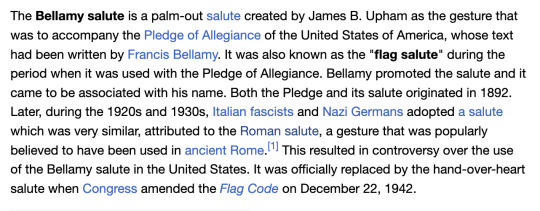
THEN it was coopted by N*zi's and US stopped using that symbol in the 1940s and replaced the pledge with their hand on their heart.
NOW it is consistently used by neo-N*zi's and modern fascist groups!
(Below) For example - Neo-N*zi's in Victoria, Melbourne at an Anti-Trans demonstration (Source) (Source)
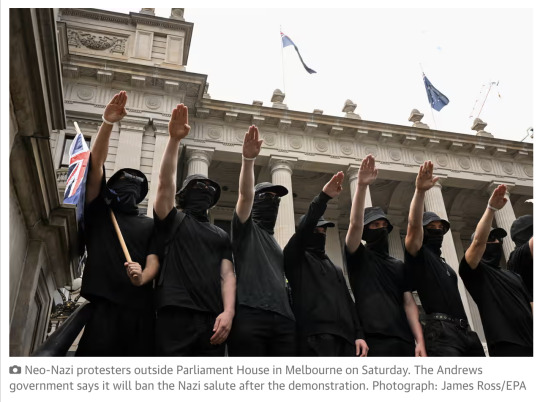
And no matter how you try to hide it as a "Roman salute" - IT IS STILL A FASCIST SALUTE?!
Pledge of Allegiance my ASS.
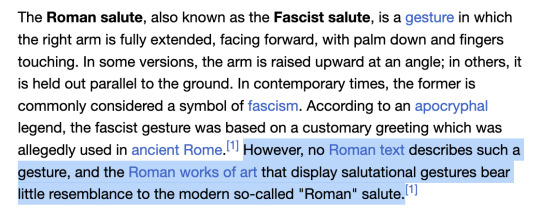



The Oath of the Horatii (1784), by Jacques-Louis David
Plus - Origins of White Supremacy and Neo N*zi Symbols
BONUS! Extreme right and neo-N*zi's are eating it up.

Elon Musk just did the sieg heil at the inauguration???? DOG?
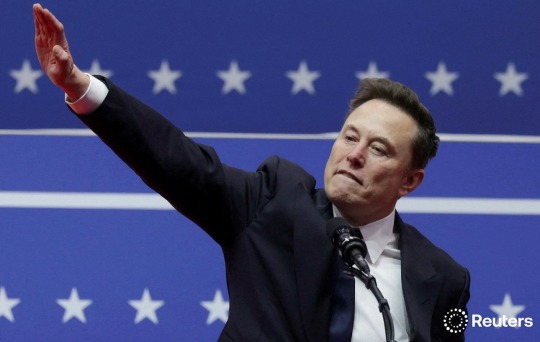
11K notes
·
View notes
Text
Modern Australia No Longer Represented By Libs

The Liberal Party of Australia have won no metropolitan seats in Adelaide and almost none in Sydney and Melbourne. Where does the greater part of the Oz population reside? In the cities, of course. Modern Australia no longer represented by Libs. This once popular political party is no longer representative of the modern Australia and Australians. Peter Dutton led the Libs further Right and has taken them into the smaller territory of that extremist category within the political sphere. It features a male dominated, Anglo-settler white is right, ethos which regularly attacks multiculturalism, refugees, LGBTQI folk, renewables and climate change, and ‘woke’ – which is really an attack on smart women and diversity. Inspired by Trump in the US, the Libs want to turn the clock back to an Australia where patriarchy and white men rule the roost and others know their place at the back of the queue. “The Liberal party has been decimated in major cities – with just a handful of seats left in Melbourne, Brisbane and Sydney – and must overhaul its appeal in urban areas despite a Coalition party room now dominated by regional Liberals and the Nationals. The Liberals have also been wiped off the map in Adelaide and Tasmania and lost another seat in Perth. Across major cities, the party has failed to win back any seats from the teal independent MPs, who strongly appeal to moderate Liberal voters.” - (https://www.theguardian.com/australia-news/2025/may/04/liberal-vote-decimated-in-major-cities-with-coalition-now-dominated-by-regional-mps-and-nationals)

Photo by Belle Co on Pexels.com
Liberal Party Of Australia Needs A Name Change
I think a name change is in order, anyway. I mean how can you be a hard right conservative political party and call yourself Liberals. Talk about confusing. However, it does chart just how far this organisation has come since Robert Menzies founded the party back in 1944. I suppose you have to see everything within the perspective of the times and their main opponent the Australian Labor Party (ALP). If 30% of the adult voting population voted for them in this last federal election this is who identifies with their agenda and ethos. 70% did not, however. Women and younger women especially, in the main, did not vote for the Libs. The ‘strongman’ bullying style of Peter Dutton did not go over well with modern women, it seems. The Liberal Party Reaches Irrelevance In Today’s Australia Progress is inevitable and we need an inclusive progressive government in Australia. The Libs went down the moaning and whinging about ‘woke’ route and thought that this would result in electoral success in the suburbs. It failed to bear fruit, the so-called ‘culture wars’, which demonised demographics and groups like trans people over their identity, international students and immigration more generally, consistently opposes renewable energy on ideological grounds, and ogles Trump’s America as an inspiration for Australia were not popularly received. The Dutton nuclear agenda was viewed as the fringe idea that it was and not consistent with that of a mainstream political party policy platform. Modern Australia no longer represented by Libs.
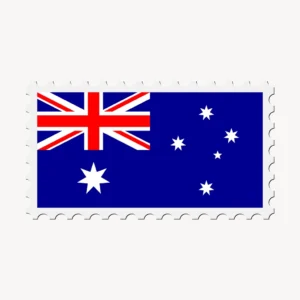
The Selfish Ethos Of The Liberals I would put forward my view that the Libs are the party of selfishness. Their leaders and policies represent an overwhelming concern for individual wealth aggrandisement. They do not govern for all Australians but, rather, for propertied folk over renters and ordinary workers. Peter Dutton was revealed to be cashing in on his position for personal gain during his years in public office and Australians were not impressed on this score. Community always comes second to individual hip pocket concerns with the Libs. Over the years they have opposed Medicare calling it socialised medicine. Their policy platforms have more in common with Donald Trump and the Republican Party in the US than the more centrist policies of ALP governments. Neoliberal policies have pushed privatisation, which has seen the transfer of assets from public ownership into the hands of the super wealthy 1%. Privatising government services is their agenda and slashing the civil service and spending billions with consultants like PwC is their well-trodden track record. Corruption and jobs for the boys surrounds this transfer of wealth from public to private hands. I think that many Australians are sick of this selfishness and see the need for a much greater community spiritedness. Dutton’s Alarmist Stratagem The alarmist warnings, which Peter Dutton constantly espoused about situations, are a part of this stratagem. Because if you threaten the security of folk by ‘crying wolf’ about China, Indigenous Australians during the Voice, criminal stateless refugees running amok in the streets, and the myriad of other Dutton emergencies it makes folk think of their bottom line. Men and women reach for their wallets and purses in a crisis. Neocon paranoia is predicated on this fear mongering by their political leaders. Peter Dutton was a strongman big on alarming the population. Australians, I think, were heartily sick of it. “Peter Dutton is that boy who keeps crying ‘wolf!’ The alarmist leader of the opposition has been busy warning about Russian planes possibly landing in Indonesia. Penny Wong, the Foreign Minister, tells us that ‘Temu Trump’ just made up stuff purporting to come from the Indonesian President. The ex-cop from Queensland wants Aussie citizens to be worried and alarmed, so that he can beat his chest. “ - (https://wordsforweb.com.au/peter-dutton-is-an-alarming-politician/) The average Liberal voter is a white man in his 70s and the average Australian is a 37 YO woman. Robert Sudha Hamilton is the author of America Matters: Pre-apocalyptic Posts & Essays in the Shadow of Trump. ©WordsForWeb

Read the full article
#ALP#American#Australia#economics#election#LiberalParty#moralfailure#PeterDutton#politics#power#Trump
0 notes
Text

Introducing teeth dreams - and you'll live
@teethdreamer is a Melbourne-based experimental ambient noise project known for crafting immersive soundscapes that blend melancholy drones, static textures, and field recordings.
Interview //
When did you start making music and what did that look like at the time?
In some form or another I've been making music since I was a teenager, having played in numerous punk and emo bands as a kid into my early 20s. Nothing ever really became of any of those projects -- the last of my adolescent emo bands broke up because our drummer moved interstate to build rocket ships, the vocalist also left town a few years later to pursue a masters degree and is now (I believe, I'm bad at keeping up with people's movements) an immunologist -- so I began to spend an increased amount of time with my solo project. The initial version of this project (which cycled through a number of names, but for the majority of its existence has been called Teeth Dreams) started out as an unwieldy mixture of drone, folk, noise and screamo. Sorta like an unholy union of Grouper and City of Caterpillar with a not-insignificant amount of Phil Elverum thrown in for good measure... it was a bit of a mess.
How has the process transformed over time and what inspired that change?
The pivotal change honestly was brought about by technological limitations. I spent several years (2017-2021) writing and recording the same album over and over, losing it several times due to hard drive failure, my house getting robbed and numerous other boring misfortunes. Each time I returned to the record it became increasingly minimal and droney, with fewer and fewer actual "songs" surviving the process. Eventually all I had was a collection of low quality mixdowns of some of my drone tracks -- which I eventually released as the demo "Drifted in the punt, late in the backwater". At that point I basically embraced the fact that Teeth Dreams wasn't what it had started out as, I preferred the space I'd found myself in with the project (and nothing remained of it's former-self anyway) so I committed fully to the fusion of ambient drone and harsh noise that's come to define the project.
How has your trans identity impacted your music practice (if at all)?
The main impact has really been having a peer-group of fellow queer and trans people to perform alongside and collaborate with. While I suspect I probably would've found myself making the music I am regardless of my transness, having a community of fellow-travellers has undeniably pushed me to take my work more seriously and be the best I can be. I like to think we all lift each other up, in a certain sense.
Who do you make music for?
It's perhaps a little abrasive, but I'm seriously considering printing t-shirts that read "EMOTIONAL HARSH NOISE FOR FURRIES AND FAGGOTS" because, while there are plenty of people who enjoy my music that don't fit into either of those categories, I really do feel like the people I encounter at shows and online who are most enthusiastic about what I'm doing are fellow queers and furries. Also, I feel like if you're straight and can't roll with the fact that I'm a weird sad pervert primarily trying to connect with other weird sad perverts, then I'm not really sure you'll get much out of the experience anyway. I could be wrong though, I'm just making music because I feel compelled to do it by forces I couldn't control if I tried. I'm grateful people are into it -- enough so that they pay for my music and ask if they can buy merch -- but I honestly feel like thinking to much about who I'm making things "for" is probably going to give me some sort of heinous anxiety spiral and kill the enjoyment for me. At the end of the day, I'm a very nervous person...
In three words, what can we expect from your track on the compilation?
Melancholic radio static
Official Sites & Socials
https://www.instagram.com/teethdreamer
0 notes
Text
For context, in Australia indigenous groups have largely been massive supporters of Palestinians, and on 'Australia Day' (when we celebrate the start of a genocide in Australia) the weekly Palestinian Rally was invited to the Invasion Day protests. So we had tens of thousands of people showing up to support Palestine AND indigenous people. Same fight.
The one in Naarm (Melbourne) was so big that I couldn't even get close enough to see the speakers during it!
It was a sea of Palestinian flags, Indigenous flags, Pride flags and Trans Pride flags!
Of course, very little media coverage...
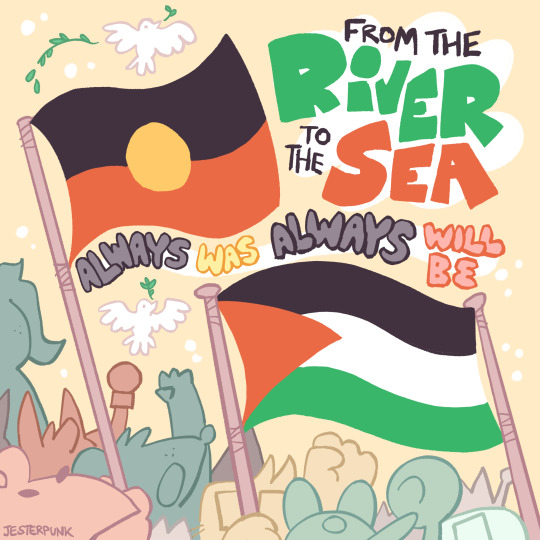
[ID: A digital painting in pastel colors showing a colorful crowd of different animals holding a Palestinian and Indiginous Australian flags, with text above them that reads, "From the river to the Sea, always was, always will be", with white doves flying next to the flags. A small artist's signature at the bottom reads, "jesterpunk". End ID.]
🕊️ every year in my lifetime, I've seen an ugly blue british flag printed on single use cups and ugly tshirts on January 26th, celebrating stolen land, stolen language and stolen children. this year in particular, I feel the need to make my politics clear through art, as the horrors of colonialism and genocide are mirrored internationally in Palestine. I want to be clear, you do not get to enjoy my art without knowing clearly what my politics are, and you do not get to ignore my politics as an inherent part of my art. no one is free until everyone is free 🖤💛❤️🇵🇸
[Emoji description: A white dove with a green sprig. A black heart, a yellow heart, a red heart, and the Palestinian flag. End emoji description.]
11K notes
·
View notes
Text
The biggest Southern Hibernation blasts off this weekend!
New Post has been published on https://qnews.com.au/the-biggest-southern-hibernation-blasts-off-this-weekend/
The biggest Southern Hibernation blasts off this weekend!
A highlight in the Australasian bear community calendar, Southern Hibearnation blasts off this weekend with fur, fun and frivolity.
Since 1998, Southern Hibernation has annually hosted free and ticketed events for local, interstate and overseas bears, and their admirers.
The 25th Southern Hibearnation (let’s not talk about Covid) kicks off this Saturday.
It’s the biggest bear event in Australia and New Zealand, and this year it hosts thirteen events over nine days.
The VicBears committee are all set for Saturday’s opening night party with President Adam Walton bursting with excitement.
“This is the biggest number of events we’ve ever had,” Adam told QNews.
“Southern Hibernation is normally mostly nighttime events, and with so many interstate and overseas bears coming to Melbourne for a holiday, we wanted to give them some fun activities too.”
This Sunday hosts an Arcade Day with a history LGBTQ+ walk through the city and Fitzroy, hosted by Holi Dae Knight and Mr VicBear 2024 Billy on Tuesday.
“We are also doing a lunch at Stomping Ground and heading to Spotswood and going to Grazelands, because bears love to eat.” Adam laughed.
“We have so much happening during the day, with a lot of it unticketed.”
“Southern Hibernation brings the bear community together, not just from Australia but New Zealand as well.
“For some of us around the country, it’s our annual catch-up.”
Source: Facebook
The countdown has begun.
Southern Hibernation was the first bear event in Melbourne that Adam attended in 2014.
A friend who had tickets to all the events had fallen sick and told him to take his place.
“I had no idea what to expect, but since then I haven’t looked back,”
“I joined the committee and am rounding out my final year as President this year,” he said.
Which is one of the reasons Adam wants this year’s events to be such a success.
With a running theme of ‘Bears in Space, ‘ it looks like it’s going to be nine days of intergalactic furry fun.
Kicking off with a Welcome Party at The Laird on Saturday, followed by a Bear Invaders Arcade Day on Sunday, with a lunch at Stomping Ground and Bearaoke on Monday.
There’s a history walk on Tuesday during the day with Laser Bears in the evening and Underbear on Wednesday night.
The Bears take over Wet on Wellington with Spa Bears on Thursday, and then Meet the Contestants on Thursday before the Mr Australasia Bear Comp on Friday.
Saturday afternoon sees Bears be Eating with Hunk: Alien in the evening, and it all Rounds up on Sunday at UBQ.
View this post on Instagram
A post shared by DEANation (@deanuswiththebig)
Who will be Mr Australasia Bear 2025?
With so much on, it’s not just the interstate travellers on a holiday, with many of Victoria’s bear community taking the week off.
“I know it sounds naff, but what makes Southern Hibernation so special is the community,” Adam told us.
“We get to come together, we get to celebrate each other, and for a week, we have parties and dinners and plenty of fun.”
One of the events that Adam is really looking forward to this year is Meet the Contestants, a social event before the Mr Australiasia Bear Competition.
“It’s a chance for the guys competing to be onstage without the pressure of the competition,” Adam said.
“It’s a chance for everyone to see them in a different light before the big night, when they are a lot more relaxed.”
Last year hosted the most diverse group of bear competitors Mr Australiasia Bear had ever had, something that continues this year with two trans contestants.
“One of my goals coming into a leadership position on the committee was to make the club more trans inclusive,” Adam said
“When I first came to VicBears, there were some people who just couldn’t figure out how to do that, and that was something I happily wanted to help with.”
“As we’ve continued seeing more trans bears come to events, it has been really fantastic.
“Not to say that that work is done, but it is great to see this progress in our bear communities.”
Source: Facebook
But what if you’re a newbie?
As one of the judges of the Mr Australasia Bear competition this year, Adam’s advice for competitors is simple.
“If you look at the previous Mr Australiasia Bears, one thing they all have is their approachability.”
“They’re just nice people to be around, and that’s the main quality I look for.”
While many of the ticketed events are sold out, there are still some free ones on offer.
So if you’re new or interested in dipping your toe into the bear scene, Adam recommends coming to the Opening Night Party this Saturday.
“It’s a free event at The Larid and we are doing burgers and door prizes, so even if your budget is a bit tight, it’s a good one to come to.”
“The same with Bearaoke on Monday night or coming to the lunch at Stomping Ground,” Adam said.
“And while Bathhouse Bears isn’t free with you paying at the door at Wet, that is a great event as well.”
“The team from Thorne Harbour Health’s Down and Dirty will be there if you want to talk about sex or safety when playing with someone.”
“And there’s a free BBQ.” Adam laughed, “Because we are bears and we love food.”
Find out more about Southern Hibernation here.
Source: Facebook
For the latest LGBTIQA+ Sister Girl and Brother Boy news, entertainment, community stories in Australia, visit qnews.com.au. Find us on Facebook, Twitter, Instagram and YouTube.
0 notes